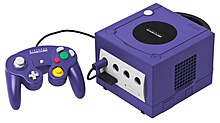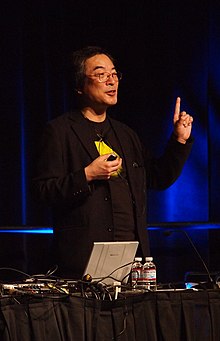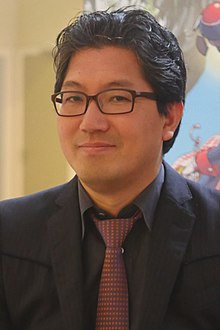Portal:Video games
The Video Games Portal

A video game or computer game is an electronic game that involves interaction with a user interface or input device (such as a joystick, controller, keyboard, or motion sensing device) to generate visual feedback from a display device, most commonly shown in a video format on a television set, computer monitor, flat-panel display or touchscreen on handheld devices, or a virtual reality headset. Most modern video games are audiovisual, with audio complement delivered through speakers or headphones, and sometimes also with other types of sensory feedback (e.g., haptic technology that provides tactile sensations). Some video games also allow microphone and webcam inputs for in-game chatting and livestreaming.
Video games are typically categorized according to their hardware platform, which traditionally includes arcade video games, console games, and computer (PC) games; the latter also encompasses LAN games, online games, and browser games. More recently, the video game industry has expanded onto mobile gaming through mobile devices (such as smartphones and tablet computers), virtual and augmented reality systems, and remote cloud gaming. Video games are also classified into a wide range of genres based on their style of gameplay and target audience. (Full article...)
Featured articles –
Game development occurred in parallel with Final Fantasy VIII. Envisioned by developers as a retrospective for the series, it departed from the futuristic settings of Final Fantasy VI, VII, and VIII by returning to the medieval style of the earlier games. Consequently, it draws heavy influence from the original Final Fantasy and features allusions to the rest of the series. The game introduced new features to the series despite this approach, such as "Active Time Event" cutscenes, "Mognet", and skill systems. Final Fantasy IX was the last game in the main series whose music was composed solely by Nobuo Uematsu.
Final Fantasy IX was released to critical acclaim and commercial success, selling more than 5.5 million copies on PlayStation by March 2016. It was re-released in 2010 as a PS1 Classic on the PlayStation Store—this version was compatible with PlayStation 3 and PlayStation Portable; PlayStation Vita support arrived in 2012. In 2016 Square Enix released an enhanced port featuring minor gameplay and graphical enhancements, which would be released on several platforms. An animated series adaptation by Square Enix and Cyber Group Studios was announced in 2021. (Full article...)
The story takes place months after Ocarina of Time. Link arrives in a parallel world, Termina, and becomes embroiled in a quest to prevent the moon from crashing in three days' time. The game introduces gameplay concepts revolving around a perpetually repeating three-day cycle and the use of various masks that transform Link into different forms. As the player progresses through the game, Link learns to play numerous melodies on his ocarina, which allow him to control the flow of time, open hidden passages, or manipulate the environment. Characteristic of the Zelda series, completion of the game involves successfully navigating through several dungeons that contain complex puzzles and enemies. Majora's Mask requires the Expansion Pak add-on for the Nintendo 64, which provides additional memory for more refined graphics and greater capacity in generating on-screen characters.
Majora's Mask earned universal acclaim from critics and is widely considered one of the best video games ever made. It received praise for its level design, story, and surrealist art direction, and has been noted for its darker tone and themes compared to other Nintendo titles. While the game only sold about half as many copies as its predecessor, it generated a substantial cult following. The game was rereleased as part of The Legend of Zelda: Collector's Edition for the GameCube in 2003, and for the online services of the Wii, Wii U, and Nintendo Switch. An enhanced remake for the Nintendo 3DS, The Legend of Zelda: Majora's Mask 3D, was released in 2015. (Full article...)
Director Shigeru Miyamoto conceived a 3D Super Mario game during the production of Star Fox (1993). Development lasted nearly three years: about one year on design and twenty months on production, starting with designing the virtual camera system. The team continued with illustrating the 3D character models—at the time a relatively unattempted task—and refining sprite movements. The sound effects were recorded by Yoji Inagaki and the score was composed by Koji Kondo.
Super Mario 64 was highly anticipated by video game journalists and audiences, boosted by advertising campaigns and showings at the 1996 E3 trade show. It received critical acclaim, with reviewers praising its ambition, visuals, level design, and gameplay, though some criticized its virtual camera system. It is the best-selling Nintendo 64 game, with nearly twelve million copies sold by 2015. (Full article...)
Did you know... -
- ... that in the upcoming video game Marvel's Midnight Suns, players will be able to create their own superhero in the Marvel Universe?
- ... that the 2005 video game Bokura no Kazoku was inspired in part by the birth of its creator's first child?
- ... that development on the video game Expeditions: Rome was not affected by lockdowns from the COVID-19 pandemic because the developer was already split between Copenhagen and Istanbul?
- ... that Kainé from the video game series Nier was created in response to a female staff member's vague wish for a "male heroine"?
- ... that the 1979 video game Superman was one of the first console games with a pause feature?
- ... that a cheat code for the 2003 video game Hulk is hidden in a scene of the film it is based on?
- ... that the developers of the video game Golf Club: Wasteland jokingly announced that they would only sell one copy at a price of $500 million?
- ... that before Sarah Elmaleh voiced the player character in the video game Anthem, developed by BioWare, she voiced characters in a mod of an earlier BioWare game?
- ... that the success of Kingdom Rush prompted plans to grow the video game industry of Uruguay?
- ... that Paul Dini was a writer for both the animated television series Batman: The Animated Series and the video game series Batman: Arkham?
- ... that MicroProse was formed to publish Hellcat Ace after Sid Meier boasted that he could design a better video game than Red Baron in a week?
- ... that a cheat code in the video game Spyro: Year of the Dragon grants access to a near-complete copy of Crash Bash?
Selected biography –
Selected image -

Recent video game-related events
- May 24, 2024 – Uvalde school shooting
- Families in Uvalde, Texas, U.S., file a lawsuit against Daniel Defense and Activision Blizzard for creating the DDM4 V7 gun and promoting the weapon through the game Call of Duty, respectively. They also sue Meta Platforms for owning Instagram, which was used by the gunman. (AP)
- April 16, 2024 – 2023–2024 video game industry layoffs
- American video game company Take-Two Interactive lays off 5% of its workforce. (Reuters)
- April 10, 2024 – 2023–2024 video game industry layoffs
- American video game company Epic Games announces that it will lay-off around 870 employees, roughly one-sixth of its workforce, due to slower growth than expected. (CBC via Yahoo! News)
Topics
Categories
Things you can do
In other Wikimedia projects
The following Wikimedia Foundation sister projects provide more on this subject:
-
Commons
Free media repository -
Wikibooks
Free textbooks and manuals -
Wikidata
Free knowledge base -
Wikinews
Free-content news -
Wikiquote
Collection of quotations -
Wikisource
Free-content library -
Wikiversity
Free learning tools -
Wiktionary
Dictionary and thesaurus














































